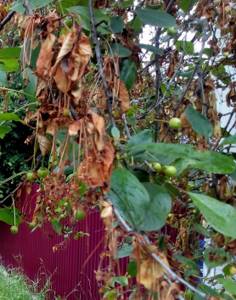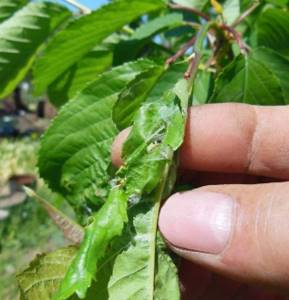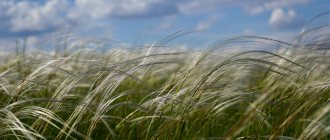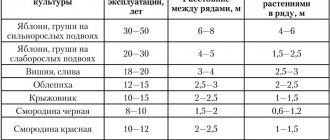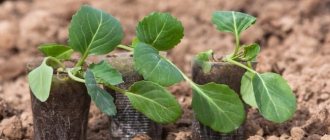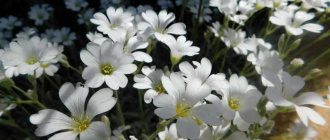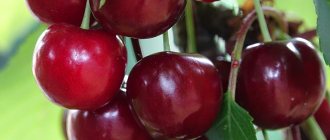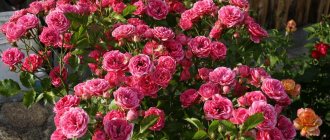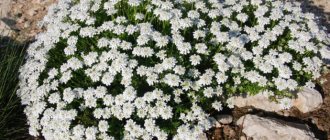How to properly plant cherry seedlings in the fall - step-by-step instructions
Cherry is a favorite of many summer residents; in popularity it is second only to the apple tree. Well, who doesn’t love juicy and tasty berries or aromatic jam? And the blooming garden will hardly leave anyone indifferent. It can grow as a tree and as a shrub plant. Currently, breeders have developed many varieties, thanks to which the southern plant has been successfully grown in the northern regions of the country. However, not everyone manages to grow and get a good harvest. There are subtleties here both in planting and care. How to plant cherries correctly so that they produce a generous harvest, this is what today’s article is about.
The Black Sea coast is considered the birthplace of cherries. From there it was brought to Rome, and then spread throughout Europe. In Rus', it began to be grown starting from the 15th century, and was used not only as a delicacy, but also as a medicine. Moreover, all parts of the plant were used for medicinal purposes: berries, leaves and even bark.
Sweet and sour fruits are rich in vitamins, minerals, organic acids, sugars, enzymes, pectin and tannins. Berries are especially rich in iron, so doctors recommend consuming berries for anemia, and the juice helps reduce blood pressure and strengthens blood vessels. But in general, fruits not only help improve immunity. Delicious berries are simply delicious fresh, and you can also prepare compotes, jam, juice and homemade wine from them.
There are several types of cherries: ordinary (also sour), bird cherry (better known as sweet cherry), sakura (finely serrated) - trees; felt and steppe - shrubs.
Varieties and hybrids of felt cherries
Both in Soviet times and in modern Russia, serious breeding work with felt cherries was carried out almost exclusively in scientific institutions of the Far Eastern region. All currently zoned varieties are of either Far Eastern or Siberian origin. The Michurin experimental varieties that once existed have not survived to this day.
The fruits of felt cherries are most often light red in color, while dark-colored varieties of ordinary cherries are more highly valued by consumers. To obtain varieties with more attractive berry colors, complex breeding work was carried out by crossing felt cherries with a closely related North American species - sand cherries, which have very attractive dark-colored fruits. Many of these complex hybrids have proven to be very successful and are still cultivated today, classified as tomentose cherry varieties.
Hybrids of felt cherry and sand cherry (table)
| Name | Fruit coloring | Fruit size (in grams) | Ripening period | Originator | Note |
| Damanka | Maroon | 3,0–3,5 | Late | DalNIISKH | A very famous and popular hybrid from the middle of the last century. Previously, he was in the State Register. At the moment it is not in the State Register; the reasons for the exclusion are unknown. It is still actively grown in amateur gardens and private nurseries. |
| Summer | Light red | 3,0–3,5 | Late | DalNIISKH | It is in the State Register. A very famous and popular hybrid of the middle of the last century |
| Alice | Maroon | 3,3–3,6 | Average | Far Eastern station VNIIR | It is in the State Register. A very popular variety at the end of the last century |
| Autumn Virovskaya | Dark red | 3,3 | Average | Far Eastern station VNIIR | It is in the State Register. Popular variety of the end of the last century |
| Natalie | Dark red | 4,0 | Mid-early | Far Eastern station VNIIR | It is in the State Register. A very popular variety at the end of the last century |
| Pink harvest | Pink | 3,0 | Average | DalNIISKH | At the moment it is not in the State Register for unknown reasons. Available in the VNIISPK catalogue. It was transferred to state variety testing in 1991 |
| Princess | Hot pink | 3,6–4,0 | Average | Far Eastern station VNIIR | It is in the State Register. A very popular variety at the end of the last century |
| Gorgeous | Dark pink | 3,0–3,5 | Late | Far Eastern station VNIIR | It is in the State Register. Popular variety of the end of the last century |
Varieties and hybrids of felt cherries (photo gallery)

Felt cherry Tsarevna
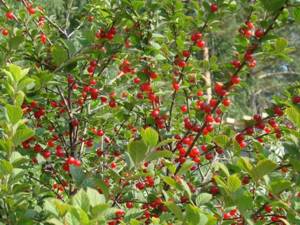
Felt cherry Pink fruitful
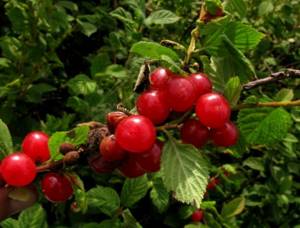
Felt cherry Autumn Virovskaya
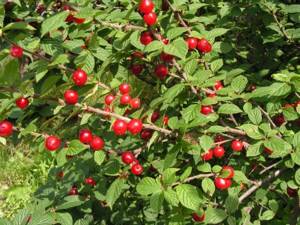
Felt cherry Ogonyok

Felt cherry Natalie Felt cherry Lyubimitsa
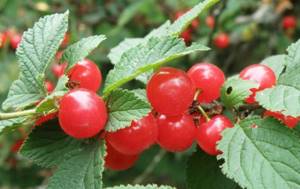
Felt cherry Summer
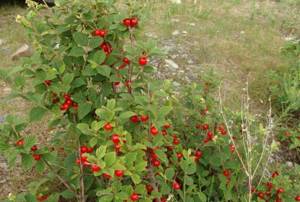
Felt cherry Lakomka
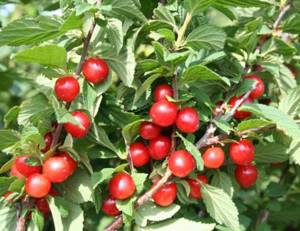
Felt cherry Beauty
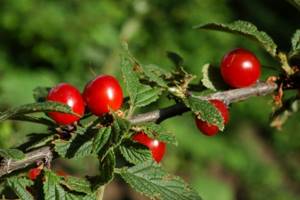
Felt cherry Marvelous Felt cherry Damanka

Felt cherry Amurka
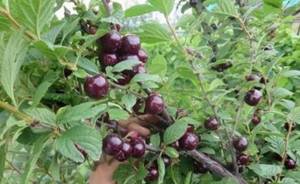
Felt cherry Alice
Other varieties of felt cherries (table)
| Name | Fruit coloring | Fruit size (in grams) | Ripening period | Originator | Note |
| Ogonyok | Red | 2,5–4,0 | Mid-late | DalNIISKH | At the moment it is not in the State Register for unknown reasons. A popular variety from the middle of the last century, it used to be in the State Register. Available in the VNIISPK catalog |
| Amurka | Red | 2,7–4,0 | Average | DalNIISKH | Available in the VNIISPK catalogue. Used to be in the State Register, but is now absent for unknown reasons |
| Favorite | Dark pink | 3,3 | Average | Far Eastern station VNIIR | New variety, present in the State Register since 2009 |
| Gourmand | Red | 3,0 | Early | Far Eastern station VNIIR | Currently not in the State Register for unknown reasons |
| Marvelous | Scarlet red | 3,0–3,5 | Average | Agro | Not in the State Register. Seeds of this variety are offered for sale on the Agro website |
| Burgundy | Scarlet-burgundy | 3,6 | Average | Unknown | It is not in the State Register, it is also not in the VNIISPK catalogue, it is not mentioned anywhere in the specialized literature. Found on the Internet only on dubious websites of private nurseries and online stores. |
Planting cherries - when is it better to plant cherries in autumn or spring
Seedlings can be planted both in autumn and spring. Each method has its own advantages and disadvantages. Why is it better to choose autumn time for planting?
- Autumn planting has the advantage that in early spring the roots begin to develop quickly and the plant quickly begins to grow.
- When planting in autumn, unfavorable factors for rooting the root system are minimized. Therefore, trees planted in the fall are about 20 days ahead in development of those planted in the spring.
- Easy to plant and saves the gardener's time. You just need to follow the correct instructions for planting and covering the tree for the winter. Special care is not required, since regular autumn rains will sufficiently nourish the root system with moisture and promote its growth until the temperature drops to -4ºC.
It is better to buy seedlings in nurseries, otherwise you can buy ordinary shoots that are produced by barren trees. When purchasing, pay attention to the condition of the root system. Typically, trees with open and closed root systems are available for sale. If you have a choice, it is better to buy with a closed one, since in this case the roots are less damaged and such a tree will grow better. But at the same time, when open, you can assess the condition of the roots.
For planting, it is better to buy annual trees with a well-developed root system and mature wood. You can buy cherries in the fall, dig them in, and plant them in a permanent place in the spring.
When choosing a seedling, make sure that the standard is about 60 cm, at least 2-2.5 cm in diameter, with a length of skeletal main branches of about 60 cm (this is the size of a two-year-old tree cherry seedling).
In what month can you plant cherries in the fall - planting dates
Specific planting dates depend on the regional climate and characteristics of the variety. But it is important to know that the tree must have time to acclimatize before the onset of the first frost. When purchasing seedlings and planting them in a permanent place, you should adhere to the following criterion: planting should be carried out 15-20 days before the onset of the first frost. Otherwise, with constant freezing and thawing of the soil, the roots of the tree will be damaged and will not be able to take root well.
Until mid-October in the Moscow region, in central Russia, the air temperature is still stable within +10-15ºС, so in these regions seedlings must be planted no later than the end of September - beginning of October. In the more severe climate of the Urals, Siberia, and the Far East, planting should be done a little earlier. The longer the rest period, the faster the wounds received during the transplant will heal.
In spring, there is a danger that immature trees may be exposed to return frosts, which can negatively affect its growth. Also in the spring the rest period for rooting will be much shorter than in the fall.
Step-by-step instructions on how to properly plant cherries in the fall
Choose a sunny site for planting seedlings; they should not be planted on the north side, otherwise they will stretch out and give a meager harvest. The cherry tree also does not like low-lying places; groundwater should be at least 1.5 m from the surface. The ideal place would be a well-lit sunny area - a hill or a gentle slope facing south or southwest. The tree should be protected from cold northern winds.
Why is it that some people’s trees are strewn with berries, while others can barely pick a handful? Even if the tree freezes a little in winter, it quickly recovers. And it is not particularly demanding on the soil, but still produces a good harvest on fertile and light soils.
Planting cherry seedlings in the fall with an open root system
It is better to prepare the hole in advance so that the soil settles by the time of planting. The size of the hole depends on the fertility of the soil. If the soil is infertile, make the hole diameter 80 cm and depth 50-60 cm. This is necessary so that there is space left to fill with fertile soil. If the soil is fertile, especially if it is black soil, the hole can be 60 cm in diameter and 40-50 cm deep.

When digging a hole, tip the top fertile layer to one side, and the bottom (infertile with sand) to the other, it is not needed. Then mix the top fertile layer with humus in a 1:1 ratio, add 0.5 wood ash, mix everything and pour it into the hole.
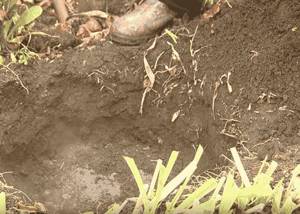
We make a mound at the bottom of the hole and place a seedling on it. We straighten the roots so that they hang over the mound and do not bend. Cover the roots with the fertile mixture and water with water, about 0.5 buckets per hole.
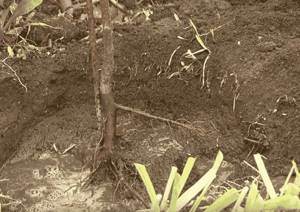
After this, we fill it completely with fertile soil so that the root collar is at ground level. There is no need to bury it, otherwise the cherry will sprout. After this, compact the soil and then mulch with humus or compost. After this, water the seedling again with water.
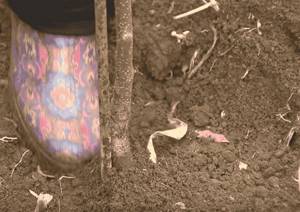
For the winter, cover the young tree with a layer of soil of 25-30 cm; in the spring, the soil will need to be removed.
How to properly plant a cherry seedling with a closed root system
For planting seedlings with a closed root system, the soil requirements are the same as for planting with an open root system. It is better to plant trees in warm, humid weather, when the temperature is still within +10-13ºС.
The hole is dug to the height of the coma. The grafting does not need to be buried; it should be above the soil level. Carefully remove the film from the earthen clod,

and then the earthen lump itself must be carefully loosened with a knife using vertical movements so as not to damage the roots. At the same time, a slight picking will occur, the roots will gain freedom and then take root better. Otherwise they will be in this coma for a long time.
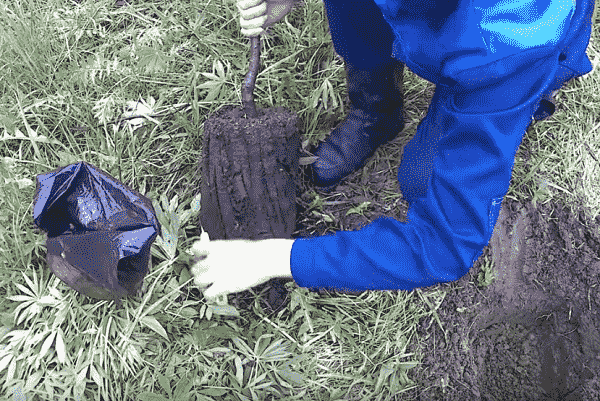
The seedling is placed in the hole so that the more developed branches are on the north side. They cover it with earth. The soil in the hole is crushed with a shovel so that it lies tightly.

Then the hole is filled with water at the rate of 0.5 buckets per hole.
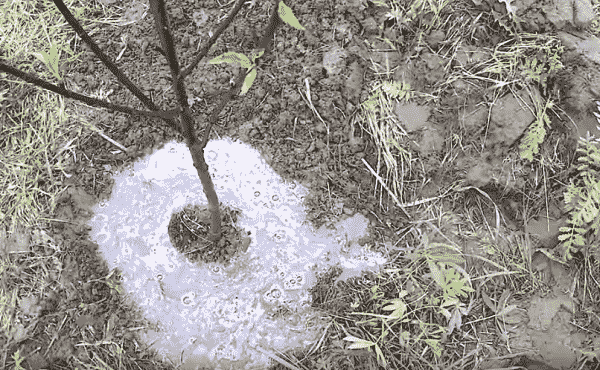
After this, more soil is added, lightly compacted with foot, and then mulched with rotted manure.

Video for beginners on how to plant felt cherry
Having seen the felt cherry blossom at least once and tasted its sweet and sour berries, you will certainly want to plant it on your site. Before planting, keep in mind that it is self-fertile; it cannot self-pollinate, like most fruit trees. Therefore, when planting, you need to take into account that varieties that bloom at the same time grow nearby. It is better to plant it in the spring until the buds bloom on the trees. But you can also plant it in the fall, since the longer the period of dormancy, the better the seedling will take root.
Felt cherries are propagated from pits, by layering, and by grafting, just like with ordinary trees. You need to know how to plant it correctly, since it has a shallow root system. But learn about everything in detail in this video.
This year I also planted 2 seedlings; I really wanted to grow delicious berries on my plot. And although our climate is harsh and unpredictable, I hope that they will grow and produce a generous harvest. And I will tell you how to properly care for cherries in another article.
Cherry agricultural technology
Planting and caring for felt and ordinary cherries are similar, but there are a number of points that need to be taken into account.
Some varieties are self-fertile, and self-fertile ones produce better yields if pollinators grow nearby. Therefore, it is necessary to place at least 3–5 trees of different varieties in the garden plot. Tree planting scheme - 2x1 m.
One of the main disadvantages of Chinese cherries is their susceptibility to moniliosis . This disease is caused by a fungus and affects all parts of the plant. It appears in the form of brown spots on greenery, which quickly dries out. Moniliosis is favored by damp, cloudy weather. To prevent trouble, it is necessary to spray the tree with 1% Bordeaux mixture before the flowers bloom. The treatment is repeated after flowering. But pests almost never bother felt cherries.
Video: why felt cherry needs prevention of moniliosis
Felt cherry is highly frost-resistant; many varieties can withstand cold down to -40 ° C, and flowers - up to -3 ° C. If, nevertheless, the winter turned out to be very harsh, and even the Chinese cherry tree froze, you need to remove the trunk at the root. Soon, shoots will appear in this place, which can produce a harvest in 3 years.
A tree lives on average no more than 10–12 years, but if you prune it on time and provide it with proper care, this period can be extended.
Video: how to prune bush cherries
Felt cherries are absolutely contraindicated in low-lying areas and stagnant moisture - this must be taken into account when choosing a planting site and watering.
Video: where you can plant cherries
If for some reason the felt cherry needs to be replanted, then you should keep in mind that the same rules apply for it as for other stone fruits. The cherry tree should be at rest during this procedure - it is best to replant the plant in the autumn, after the leaves have fallen.
Video: how to replant a cherry bush
In regions with harsh winters, the cherry root system should be protected from frost. To do this, it is enough to cover the soil under the bush with a thick layer of snow, raking up the snow in a timely manner so that a snowdrift forms. Additionally, you can insulate the cherry tree trunk with a burlap cover or wrap the stem with paper. With the beginning of spring, all coverings must be removed, otherwise the cherry tree may suffer from condensation.
Video: how to properly care for Chinese cherries
Felt cherry in the garden - all about planting, growing, pruning and propagation
Adding an article to a new collection
Any experienced gardener can care for felt cherries, however, in order to avoid difficulties at first, it is better to prepare and master the theory before moving on to practice. Let's figure out where and how to plant, how to care for and what to expect from this shrub.
The most important task of the gardener comes down to remembering the fact that the felt cherry, contrary to the prevailing stereotype, is not a cherry at all, but a plum. Therefore, it needs appropriate care, and it needs to be crossed and grafted onto plums, cherry plums, and apricots.
Description and features of growing felt cherries
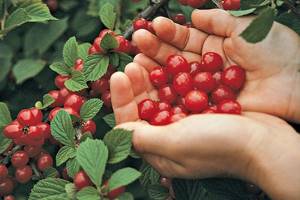
Felt cherry is named due to the pile that especially thickly covers the back side of the foliage, and in the form of individual hairs found on its front surface, on young shoots, petioles and even on berries.
A fruit shrub with brown-copper, sometimes darker, almost black bark does not exceed 1–3 meters in height. The branches are covered with oval, jagged green leaves with a pointed tip, ranging from 2 to 7 m long, depending on the variety and age of the plant. They are highly corrugated and sit on short, barely noticeable petioles. In spring, the felt cherry tree is covered in a cloud of white or pink flowers that open before the foliage emerges en masse.
The resulting fruits resemble traditional cherries, but are slightly smaller.
Today's interest in culture is quite understandable:
- Felt cherries bear fruit in the first half of summer, when the ovaries of other stone fruit crops are just forming.
- The fruits of this Asian crop, due to their lower acid content, are sweeter than the berries of common varieties of ordinary cherries and are successfully used fresh, as raw materials for jam, juice and homemade wine, and added to marinades and pickles.
- Felt cherry plantings, with proper care and pruning, become an excellent hedge.
- Plants easily adapt to the conditions of the middle zone; they are drought-resistant and cold-resistant.
Therefore, growing and caring for felt cherries will not require much time and knowledge, even for novice gardeners.
How to plant felt cherry
Before planting a felt cherry, you need to choose the optimal place for it. This culture is quite capricious, so it won’t be possible to “stick” a seedling in the first corner you come across.
Felt cherry needs an open sunny place, and the soil should be loose, well-drained and fertile. With equal success, the shrub will grow on loam and sandstone, provided the soil reaction is neutral. So, if you know about the increased level of soil acidity in your area, before planting felt cherries, be sure to deoxidize the soil with lime, dolomite flour, ash or gypsum.
Felt cherry: photo and description
Initially, this crop was used as a decorative one, all thanks to its luxurious greenery and beautiful flowers. The homeland of the felt cherry is China, however, it is found there in the wild, and in our gardens varieties are cultivated that were bred as a result of painstaking breeding work.
Externally, it is a small shrub with a very lush crown, the leaves are small and corrugated. Cherry blossoms look great when the bush is covered with pink and white flowers. Flowering usually begins in early May.
Berries ripen from mid-July. The fruits are small, very tightly adjacent to each other on the branch, with juicy sweet pulp and a small stone. The color of the berries depends on the variety and varies from bright red or scarlet to almost black, chocolate. Since this cherry is a low-growing shrub, it is not difficult to collect the fruits, and even very overripe cherries do not fall off the branches. The yield is good; from one felt cherry bush, with proper care, you can harvest up to 12-15 kg of berries.
The fruits contain a lot of vitamin C and iron; eating them helps improve digestion and strengthen blood vessels.
Felt cherry care
Those who have been growing felt cherries for a long time know that planting and caring for them is not difficult. The bushes are frost-resistant and winter well in the middle zone, especially if the winter was snowy. If snowless frosty months often occur in your region, the felt cherry tree must be covered with spunbond, spruce branches or other available means.
Felt cherry blossoms, especially varieties with pink flowers, are often compared to cherry blossoms
Felt cherries are fed twice a season - in the spring, immediately after flowering, and at the end of summer for a comfortable wintering. For the first time, use a mixture of 5 kg of humus, 30 g of ammophosphate, 20 g of potassium sulfide, 50-60 g of superphosphate. Apply the mixture around the perimeter of the tree trunk circle, embedding it to a depth of 20-25 cm (bayonet of a shovel). The second time (end of August - beginning of September) a complex mineral fertilizer that does not contain nitrogen is used, for example, Autumn, according to the instructions (on average 40 g per bush).
If you don’t know what to feed the felt cherry, give preference to organic matter in combination with ash - this will give the tree nutrients and deoxidize the soil.
Otherwise, this crop is unpretentious: water it during dry periods, and during fruit ripening - at least once a week, but do not let the water stagnate at the roots. Remove weeds from the tree trunk and make sure that the mulch does not cover the root collar - felt cherry often suffers precisely because of damping off.
But we will have to write a separate article about what diseases the felt cherry is characterized by and what treatment it may need. This culture is therefore unpopular in our gardens because it often becomes a victim of moniliosis and pocket disease, from which it dies and infects surrounding plants.
Planting and care
Felt cherries are planted in autumn or spring. It is preferable to use two-year-old seedlings, which take root well in a new place and quickly begin to grow. The holes for planting are dripped at least a month in advance, and care must also be taken to prepare fertile soil, which will have enough nutrition for the first few years of the bush’s life. 30 grams of potassium fertilizers, 40 grams of phosphorus fertilizer, three buckets of organic matter and 1 kilogram of lime are added to the planting hole.
Immediately before planting, you should trim the roots of the seedling to 25 centimeters, and then dip them in a clay mash. After planting, the soil is carefully compacted, the plants are watered, and the tree trunk circle is mulched with peat. In the first year, it is not necessary to additionally feed the felt cherry, and subsequently, fertilizers are applied annually immediately after flowering. Once every 5 years, lime is added to the soil, which helps maintain an optimal level of soil acidity. Caring for plantings involves annual thinning of the central part of the bush, for which the plant is left with 12-13 strong branches. It is necessary to feed felt cherries with both organic matter and phosphorus-potassium fertilizers. The gardener should focus on the condition of the plant and its growth rate, additionally adding nutrition to the soil, which allows him to obtain the highest possible yield. Felt cherry is an early ripening, fast-growing plant that begins to bear fruit abundantly already in the third year after planting.
Read: Cucumbers and beans - a successful tandem
Approximately once a month during the growing season, you will need to water the felt cherry, but you should not allow the soil to become waterlogged. Water for irrigation is used that is settled and warm. This is a cross-pollinated crop, therefore, in order to achieve an excellent harvest, it is necessary to plant several varieties of cherries on the plot. Additionally, during flowering, the plant can be sprayed with sweetened water, which attracts pollinating insects.
Every year, in early spring, even before the start of sap flow, it is necessary to carry out formative pruning, leaving the bush with 12-13 powerful skeletal branches, which subsequently bear fruit well. Felt cherry produces numerous basal shoots that must be mercilessly cut out. Such wild plants practically do not bear fruit, but at the same time they take away food from the bush. In the fall, after harvesting, experienced gardeners also prune the plants, removing damaged and dried shoots.
How to trim a felt cherry tree
Pruning felt cherries is a necessary procedure for those gardeners who want to extend the life of their plants. After all, on average, this bush bears fruit actively for up to ten years, and with regular rejuvenating pruning you can give it another 5-7 years of productivity.
The main number of ovaries are formed on the branches of this year, so the old ones need to be renewed regularly. Large-scale rejuvenating pruning of felt cherries is carried out once every five years, but every year (in the spring before buds open or in the fall after the onset of frost) the crown is thinned out. At the same time, there should be no more than 10-12 developed shoots on the bush, diverging to the sides and not thickening the center. Everything that grows inside the crown is mercilessly removed into the ring. In the same way, once every 2-3 years, part of the skeletal branches is removed so that young ones grow to replace them.
Annual shoots should not be longer than 60 cm, so if they are clearly overgrown, shorten them so that the bush directs its energy to fruiting rather than growing branches and foliage.
Diseases and pests
| Moniliosis Symptoms:
Treatment:
|
| Pocket disease Symptoms:
Treatment:
|
| leaf roller Symptoms:
Treatment:
|
How to propagate felt cherry
Felt cherries can be propagated in three ways: by pitting, cuttings and layering. True, in the first case, young plants will not inherit varietal characteristics, but will retain only specific ones.
So, if it doesn’t matter to you what kind of felt cherry you end up with, you can collect ripe berries from the tree, remove the pulp from them, rinse and lightly dry. Then mix them with sand and put them in the refrigerator until October. In mid-autumn, sow the seeds in holes 3 cm deep and do not forget to mark this place in the garden bed. In the spring, seedlings will appear, which will grow by 30-50 cm over the season and will be ready for transplanting to a permanent place.
If you want to preserve the felt cherry variety, it is better to resort to the second and third methods of propagation. Cuttings of the crop are carried out in the first half of summer, while the young growths have not yet begun to become lignified. Cuttings 15 cm long are cut so that there is a 2-3 cm piece of old wood at the base. Then the cuttings are immersed in Kornevin or another root formation stimulator (according to the instructions) and the cuttings begin to be prepared.
Description
This cherry belongs to the Plum genus, and is genetically quite distant from ordinary cherries. This is a low tree or shrub 1.5-2.7 m high. The root system is superficial. There are several trunks, perennial branches are brownish-brown in color, young ones are green or gray-green.
The name “felt” arose because the leaves, fruits, and sometimes shoots are covered with soft fibers that resemble felt. The leaves have an oblong shape, they are wrinkled, similar to corrugated paper. Medium-sized flowers are white or pink. The fruits are red drupes with a ridge in the middle and a pointed tip. The petioles are very short, the berries seem to be glued to the shoot and are located close to each other. The bone does not separate from the pulp. With good pollination, and for this you need to plant several varieties, since most felt cherries are self-sterile, bloom and bear fruit profusely. The flowering bush looks very beautiful and can be used for decorative purposes. Chinese cherry blossoms in the second half of May. The berries ripen in mid or late July.

A characteristic feature of the felt cherry is corrugated leaves and short stalks
Felt cherry: planting and pruning in spring, autumn
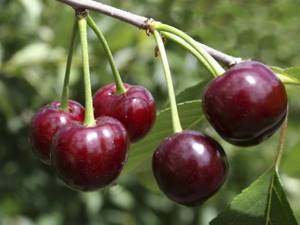
Felt cherry has a lot of advantages: early fruiting, stable yield, unusually high frost resistance, decorativeness. The fruits ripen a week and a half earlier than ordinary cherries, they are convenient to pick (maximum plant height is 2.5–3 m), and they practically do not fall off.
In addition, felt cherry decorates the garden in early spring; its bushes with a dense spreading crown are suitable for creating hedges.
Description and photos of popular varieties
There is quite a wide variety of felt cherry varieties.
Natalie
This variety has a vigorous tree with a wide, medium-dense crown. The fruits are sweet and sour, purple in color. The pulp is juicy, dense, average weight - 4 g. Natalie has the largest fruits, but during abundant harvests the berries become smaller. The variety is self-fertile and therefore needs pollinators nearby. Average yields are about 7 kg per season. Natalie's peculiarity is good resistance to clasterosporiasis.

The Natalie variety has the largest berries
Fairy tale
The bush grows up to 1.3 m. The oval, medium-dense crown consists of straight gray branches. The leaves are dark green, oval-elongated, with a sharp tip. The fruits are sweet and sour, dark burgundy, with dense pulp. The average weight of a cherry is 3.5 g. A fairy tale produces about 10 kg of berries per season. The variety is self-fertile.
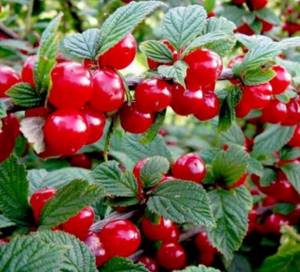
The average weight of Skazka berries is about 3.5 g
Harvest
The fruitful one has a wide spreading crown. The berries are not very large (average weight - 2.6 g), sweet and sour in taste, dark pink in color, with dense pulp. The variety is self-fertile and has a good yield among Chinese cherries - up to 12 kg per season from one bush.
Children's
Self-fertile bush with a wide, medium-dense, oval-shaped crown. The sweet and sour, bright red, dense berries are quite large - the average weight is 3.7 g. The variety is one of the most productive - up to 15 kg of fruit can be harvested from one plant.

Children's - record holder for yield among felt cherries
Tsarevna (Tsarina)
A low tree with a wide-oval spreading crown of medium density. The cherries are crimson-pink in color, with sourness, the flesh is not very dense. The average fruit weight is 3 g. The variety is self-fertile. One of the features of Tsarevna is its excellent frost resistance. Suitable for growing in northern regions. The tree can withstand frost down to -40 ° C.
The variety is sometimes found under the incorrect name Tsarina.

The princess is also called the Queen
Alice
This is a low tree with a dense crown. The weight of dark burgundy berries is about 3 g. Their pulp is juicy, dense, bright scarlet in color. The sourness is clearly expressed. The average yield of the variety is 8.5 kg. Alice is self-fertile and therefore does not need pollinators.

In Alice's fruits the sourness is pronounced
Summer
This is one of the first varieties of felt cherry, which is the “parent” for many others. The upright tree is compact, its growth in the first years of life is practically unnoticeable. Summer resists moniliosis well, but is more susceptible to attacks by the codling moth than others. Cold resistance is not very high, so you definitely need to take care of shelter for the winter. The berries are sweet with sourness, slightly fresh in taste, juicy, scarlet in color with a less bright color at the stalk, average weight - 3.5 g. The variety is self-fertile, average yield - from 8 to 10 kg of fruits per season.
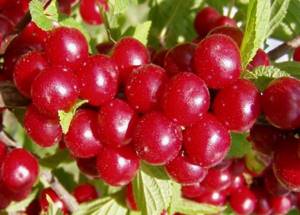
Summer became the parent for many other varieties
Firework
The tree is low-growing, with a spreading oval dense crown. Salut begins to bear fruit quite late for felt cherries - 4–5 years after planting. The variety is self-fertile, the yield is not bad - up to 10 kg. The pubescence is clearly visible on the crimson-pink berries with bright scarlet flesh. The average fruit weight is about 3.5 g.
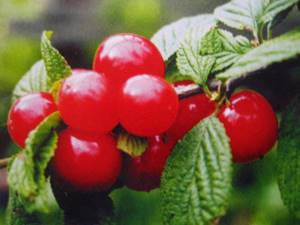
Cherry variety Salyut begins to bear fruit only 4–5 years after planting
Morning
The bush is compact and grows quickly. The crown is not very thick. The self-fertile variety produces about 9 kg of berries per season. Red, juicy pulp, small (average weight - less than 3 g) berries are almost devoid of pubescence. The Morning variety resists clusterosporia blight well and is practically not attacked by the codling moth.

Berries of the Morning variety - almost without the edge characteristic of felt cherries
Delight
The average weight of the fruit is about 3.3 g. The top of the berry is slightly slanted, the color of the cherries is bright scarlet. The pulp is fibrous, dense, juicy. During the season, this medium-sized tree with a dense spreading crown produces up to 9 kg of fruit. The variety is self-sterile, so you need to take care of pollinators.
Okeanskaya Virovskaya
The tree is tall - from 1.8 m, without pruning it can grow up to 2.5 m. The average weight of the fruit is small - 2.8 g. The berries are bright burgundy, the seam is almost invisible, the stalk is very small. This is a self-sterile variety. If there are pollinators in the neighborhood, it produces a full harvest - about 9 kg from an adult tree. A characteristic feature of cherries is the almost complete absence of odor.
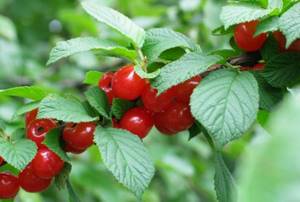
Ocean Virovskaya cherry has almost no smell
Damanka
One of the latest varieties. Its ripening period is the first ten days of August, and the berries of other varieties can be collected in mid-to-late July. Damanka is similar to one of its parents - sand cherry. A medium-sized tree with a rounded crown produces up to 10 kg of fruit. It is important to take into account that the variety is self-sterile and will not bear fruit without pollinators. Damanka berries are large, dark (almost black), the pulp is dense and fleshy.
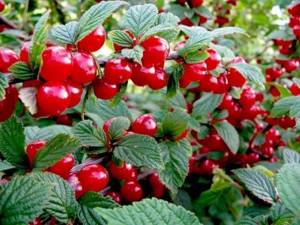
Damanka is one of the latest varieties
The peculiarity of the variety is that Damanka is less susceptible to moniliosis than others.
Gorgeous
The crown is wide, dense, the height of the tree is about 1.6 m. The berries are round, slightly flattened on the sides, covered with crimson skin. The pulp is scarlet and juicy. The average weight is 3.3 g. The variety is self-sterile, but with pollinators it can produce 10 kg of berries. However, if the harvest is too large, the berries become smaller. The transportability of the fruit is not very high.
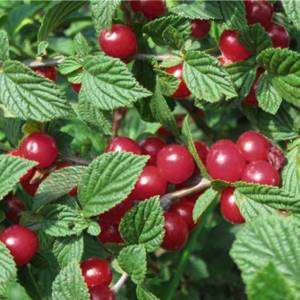
In the presence of pollinators, the Beauty cherry can produce up to 10 kg of fruit
Beauty has good resistance to coccomycosis.
Eastern dark-skinned woman
The tree is low-growing and widely spreading. The fruits are small (average weight - about 2.7 g), but spectacular - dark burgundy in color, almost black when fully ripe. The taste is sweet and sour, with tender flesh. The variety is self-fertile. Productivity is low - up to 7 kg.

The variety got its name for the dark color of the berries.
White
A tree of medium height with a spreading crown. The fruits are sweet and sour, with juicy pulp, average weight - 1.8 g. This variety of felt cherries is easy to recognize by the color of the berries - they are matte white. The variety is self-fertile, yield is up to 10 kg.

The White cherry variety is easy to recognize by the color of the berries.
Anniversary
The vigorous tree of this self-fertile variety has an oval, medium-dense crown. Cherries are dark red in color, with juicy pulp. Average weight - 4 g. Average yield - up to 8.5 kg.
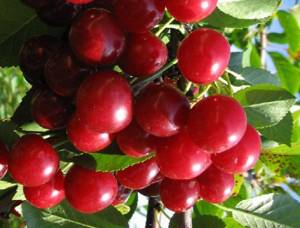
Jubilee berries have fibrous, juicy pulp
Planting felt cherry
Felt cherry grows in fertile, light, well-drained soil. It is advisable to lime acidic soil before planting.
You need to choose a sunny place for planting the felt cherry; it does not tolerate shading at all.
Taking into account the self-sterility of the felt cherry, for better pollination it is necessary to plant at least three varieties blooming at the same time. By selecting varieties of early, medium and late ripening, gardeners can extend the period of consumption of fresh felt cherry fruits for a month or longer.
The pit is prepared 2-3 weeks before planting as follows:
1 . For the seedling, dig a hole with a depth and diameter of up to half a meter.
2. Fill the planting hole with a well-mixed soil mixture with the addition of humus (compost), lime, potassium and phosphorus:
- potassium – 25-30 g,
- phosphorus – 150-200 g,
- lime – 500-800 g,
- humus (compost) - no less than 15-17 kg.
3. All ingredients must be mixed until a homogeneous mass is obtained.
4. Before planting, the roots should be soaked in a solution of root system stimulants for 1-2 hours (Kornevin, Heteroauxin, Rooter, Sodium Humate, Good Power). All these drugs help plants take root in a new place with virtually no stress.
5. Place a small mound at the bottom of the hole; its height depends on the size of the root system.
6. Place the seedling in the hole (make sure that the root collar of the seedling is 2-3 cm above ground level).
7. Gently spread the roots over the mound. When planting with an open root system, it is very important to ensure that the soil adheres tightly to the roots. In order to avoid voids, it is necessary to consistently fill up the soil and abundantly water the seedling in the hole until it becomes slurry.
8. Cover the cherry seedling installed in the hole with soil mixture and compact the soil a little, and then water it generously.
9. Mulch the ground around the cherry seedling with peat to regulate soil moisture and reduce the need for watering.
Planting felt cherries in autumn – Cottage, garden, vegetable garden, indoor plants
Good time, dear readers of our blog. I have always been attracted to the exotic garden crops that grow on the plots of some gardeners. This is exactly what I include tomentose cherries, which have successfully taken root in the gardens of the middle zone and delight their owners with excellent harvests.
It is now difficult to call it exotic, but for many this culture remains a wonderful stranger. How and when to plant felt cherries, what soils are suitable for them, agricultural techniques, the value of the berries - there are many questions, and we will try to answer them.
- Felt cherry: photo and description
- What you need to know!
- Dealing with landings
- How to properly care for felt cherries
- How and when to prune felted cherry trees
- Felt cherry diseases and their treatment
- How to propagate cherries
- Let's talk about varieties
Felt cherry: photo and description
Initially, this crop was used as a decorative one, all thanks to its luxurious greenery and beautiful flowers. The homeland of the felt cherry is China, however, it is found there in the wild, and in our gardens varieties are cultivated that were bred as a result of painstaking breeding work.
Externally, it is a small shrub with a very lush crown, the leaves are small and corrugated. Cherry blossoms look great when the bush is covered with pink and white flowers. Flowering usually begins in early May.
Berries ripen from mid-July. The fruits are small, very tightly adjacent to each other on the branch, with juicy sweet pulp and a small stone. The color of the berries depends on the variety and varies from bright red or scarlet to almost black, chocolate.
Since this cherry is a low-growing shrub, it is not difficult to collect the fruits, and even very overripe cherries do not fall off the branches. The yield is good; from one felt cherry bush, with proper care, you can harvest up to 12-15 kg of berries.
The fruits contain a lot of vitamin C and iron; eating them helps improve digestion and strengthen blood vessels.
What you need to know!
Felt cherry is a self-sterile crop, so it is necessary to plant at least two varieties nearby.
If only one variety of cherry grows in the garden, then even with proper planting and care, you won’t be able to get the fruits, since they simply won’t set and the tree won’t bear fruit.
So, when choosing seedlings in a nursery or at the market, be sure to purchase different varieties of felt cherry and do not buy bushes from unknown sellers.
Deadlines
Felt cherry seedlings are purchased from nurseries, and the best time for planting is spring. Optimal for the middle zone is April, for the north-west - maybe a little later, for example, the very beginning of May.
What to do if you bought seedlings in the fall? If this happened in September and the temperature conditions allow it and no cold snap is expected, then you can plant cherries. If the calendar says October, then it’s better not to risk it and bury the young seedlings until spring.
IMPORTANT! For seedlings that are buried for the winter, you need to carefully remove all the leaves. It is also necessary to take care of shelter in case of a frosty winter and to protect them from rodents.
Selecting a location
Cherry loves sunny places, so try to choose a comfortable, good corner on your site for it. You cannot plant this fruit crop in a lowland, and you will not get a harvest, and the tree may die.
The soil
Everything is simple here: heavy soils and peat bogs are not suitable for cherries. Grows well on sandy loam soils, as well as on light loam. It is allowed to add a small dose of organic matter, as well as phosphorus-potassium fertilizers.
Planting seedlings
Planting is carried out in prepared holes, the depth of which is approximately one and a half meters. After planting, it is advisable to lightly compact the soil and mulch it with peat. Frequent watering is not necessary; the condition of the soil is monitored and, if necessary, the seedlings are watered.
Features: before planting, it is recommended to trim the roots of the seedling a little (by about 20 cm), and then dip the roots in a specially prepared clay mash.
IMPORTANT! The root neck of the cherry seedling should be at a level of 4-5 cm from the surface of the ground.
For planting, use the following mixture as fertilizer:
- 800-900 g lime
- 30 g potassium
- 60 g phosphorus
The composition is given per 1 square meter
Be sure to control the planting pattern, planting cherries at a distance of at least 2 meters from each other.
IMPORTANT! Experts advise not to plant cherries next to conifers, as this does not have a very favorable effect on its growth and productivity.
How to properly care for felt cherries
So, the main agricultural techniques include:
- feeding;
- loosening;
- watering;
- pruning
It is recommended to fertilize two years after the seedlings are planted. Complex fertilizers are used and applied in spring and autumn. At the same time, it is important to take into account the benefits and harms of nitrogen, because in the spring it must be in fertilizers for plant growth, but in autumn fertilizing nitrogen is excluded.
Loosening is carried out as necessary; this is done very carefully, since the roots of the felt cherry are located close to the surface of the earth.
Watering is moderate; the soil should not be over-moistened.
How and when to prune felted cherry trees
The issue of pruning such cherries is very important, since this procedure promotes the growth of the bush and good fruiting.
In the first year, the cherry tree, which has reached a height of about half a meter, is carefully trimmed. In the second year, the side branches of the crown are cut off (by about one third) to prevent it from thickening.
It is best to do pruning in the spring, being sure to remove all diseased and dry branches. Visually select approximately 10-12 healthy, strong shoots, and trim the rest as well.
A thickened crown of felt cherries means diseases, fungi, low yields and even the death of the crop. If there are a lot of branches, pruning is allowed twice a year.
But as practice shows, one procedure is quite enough.
Correct, careful sanitary pruning is the guarantee that your cherry tree will not get sick, but will delight you with flowering and good harvests.
Felt cherry diseases and their treatment
A huge advantage of felt cherry is that it is practically not susceptible to coccomycosis. Experienced gardeners know how dangerous this disease is for ordinary cherries, but for this felt beauty, coccomycosis is not terrible.
But there is another danger - this is monoliosis or, as it is also called, monilial burn. The reason is a marsupial fungus that penetrates flowers and affects young shoots. When moniliosis develops in the spring, the cherry tree either loses its color or dries out after flowering, the tree stands as if damaged by fire.
In the summer, moniliosis affects the branches and trunk, the bark begins to crack, and gum appears. If no action is taken, the cherry tree will quickly die. Cherries in orchards in the Urals, Siberia, and the northwestern region especially often suffer from this disease.
How to deal with moniliosis
For prevention:
- It is necessary to choose varieties for planting that are less susceptible to this disease.
- Plant only in elevated sunny places.
- Regular pruning of the felt cherry crown is mandatory.
- It is recommended to carry out lime whitewashing of the skeletal branches of the cherry tree (at the base) and the trunk.
- Carry out special spraying to destroy insect pests that are carriers of the marsupial fungus.
If the tree is already sick, you see that some branch has dried up, then you need to immediately cut it out. During the flowering period, spraying with special preparations is allowed:
- zineb;
- inkstone;
- topsin-M.
Fruits from such trees should be used for food no earlier than 25-30 days after chemical treatment.
A good effect is obtained by treating the trunk and branches of the crown with preparations containing copper. This treatment should be done after harvesting, in order to prevent and prevent the appearance of the disease.
How to propagate cherries
Felt cherry is a very productive crop; in addition, gardeners love it for its unpretentiousness and very beautiful early flowering. Therefore, the desire to increase the number of such trees in the garden is understandable. Felt cherry can be propagated in different ways:
- Seedlings (the method is discussed in detail above).
- Layering (adult plants are used for this).
- Sowing cherry pits.
Grafting is also used, and most often gardeners use cherry plum, plum or bird cherry as a rootstock.
Propagation by layering is quite easy. To do this, in the spring, healthy annual shoots are selected from the bush, bent to the ground and pinned very carefully.
First you need to make small grooves and bend the shoots into them. Next, you need to cover the shoots with soil and water them regularly. Over the summer the shoots will produce roots and new shoots.
At the beginning of September, the seedling can be divided into several parts, or left as is, so that there is only one.
How to grow felt cherries from seeds
The method is reliable, since out of 10 seeds, usually 6-7 give a good shoot, which completely replicates the mother tree.
For planting, you need to take seeds from large, ripe fruits that are collected from healthy trees. They need to be separated from the pulp, washed and dried (not in the sun), and then stored in a polyethylene bag.
Around the end of August, the seeds are taken out, mixed thoroughly with river sand, slightly moistened and left in a cool place. Sowing is done before the onset of cold weather (each area will have its own conditions, but in time - about 20 days).
Source: https://rm-agro.com/posadka-voylochnoy-vishni-osenyu/
Felt cherry pruning
Felt cherry is more prone to thickening of the crown than other fruit trees and therefore requires careful shaping of the bush.
The formation of the crown, as a rule, is done in early spring, in March, when the period of biological dormancy still lasts. If pruning is late and the buds have already begun to grow, it is better to postpone pruning and shortening the shoots until next year. In the fall, sanitary pruning is carried out so that the plant overwinters better.
Pruning felt cherry in spring
Pruning cherry trees in spring is the most important and thorough undertaking. It is necessary to start pruning before the buds begin to awaken. Then you can begin to form the crown, simultaneously removing dry shoots.
How should you trim a felt cherry tree? Here are some recommendations.
- When forming a bush, leave no more than 10-12 strong shoots, cut out all old and broken branches.
- Felt cherry bushes are prone to thickening, so they need to be thinned out every year, removing branches that grow inside the crown.
- The bulk of the harvest comes from annual shoots, so don’t get carried away with pruning them. However, if the length of the shoot is more than 60 cm, then it needs to be shortened by 1/3.
Felt cherry diseases and their treatment
A huge advantage of felt cherry is that it is practically not susceptible to coccomycosis. Experienced gardeners know how dangerous this disease is for ordinary cherries, but for this felt beauty, coccomycosis is not terrible.
But there is another danger - this is monoliosis or, as it is also called, monilial burn. The reason is a marsupial fungus that penetrates flowers and affects young shoots. When moniliosis develops in the spring, the cherry tree either loses its color or dries out after flowering, the tree stands as if damaged by fire.
In the summer, moniliosis affects the branches and trunk, the bark begins to crack, and gum appears. If no action is taken, the cherry tree will quickly die. Cherries in orchards in the Urals, Siberia, and the northwestern region especially often suffer from this disease.
How to deal with moniliosis
For prevention:
- It is necessary to choose varieties for planting that are less susceptible to this disease.
- Plant only in elevated sunny places.
- Regular pruning of the felt cherry crown is mandatory.
- It is recommended to carry out lime whitewashing of the skeletal branches of the cherry tree (at the base) and the trunk.
- Carry out special spraying to destroy insect pests that are carriers of the marsupial fungus.
If the tree is already sick, you see that some branch has dried up, then you need to immediately cut it out. During the flowering period, spraying with special preparations is allowed:
- zineb;
- inkstone;
- topsin-M.
Fruits from such trees should be used for food no earlier than 25-30 days after chemical treatment.
A good effect is obtained by treating the trunk and branches of the crown with preparations containing copper. This treatment should be done after harvesting, in order to prevent and prevent the appearance of the disease.
